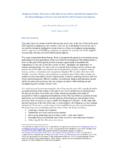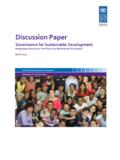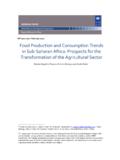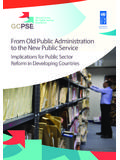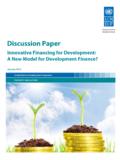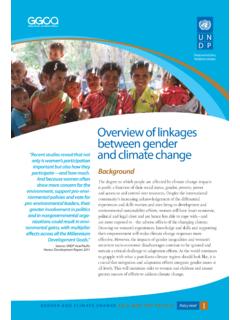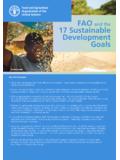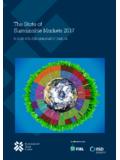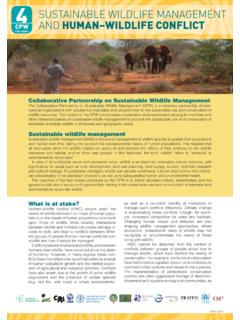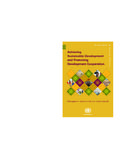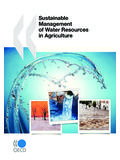Transcription of IN THE YEAR 2015, LEADERS FROM 193 COUNTRIES …
1 IN THE YEAR 2015, LEADERS FROM 193 COUNTRIES OF THE WORLD CAME TOGETHER TO FACE THE what they saw was daunting. Famines. Drought. Wars. Plagues. Poverty. Not just in some faraway place, but in their own cities and towns and knew things didn t have to be this way. They knew we had enough food to feed the world, but that it wasn t getting shared. They knew there were medicines for HIV and other diseases, but they cost a lot. They knew that earthquakes and floods were inevitable, but that the high death tolls were not. They also knew that billions of people worldwide shared their hope for a better LEADERS from these COUNTRIES created a plan called the sustainable Development Goals (SDGs). This set of 17 goals imagines a future just 15 years off that would be rid of poverty and hunger, and safe from the worst effects of climate change.
2 It s an ambitious plan. But there s ample evidence that we can succeed. In the past 15 years, the international community cut extreme poverty in half. Now we can finish the United Nations Development Programme (UNDP) is one of the leading organizations working to fulfil the SDGs by the year 2030. Present in nearly 170 COUNTRIES and territories, we help nations make the Goals a reality. We also champion the Goals so that people everywhere know how to do their part. UNDP is proud to continue as a leader in this global about the sustainable Development Goals. What s your Goal? END EXTREME POVERTY IN ALL FORMS BY , it s an ambitious goal but we believe it can be done. In 2000, the world committed to halving the number of people living in extreme poverty by the year 2015 and we met this goal.
3 However, more than 800 million people around the world still live on less than $ a day that s about the equivalent of the entire population of Europe living in extreme poverty. Now it s time to build on what we learned and end poverty altogether. END HUNGER, ACHIEVE FOOD SECURITY AND IMPROVED NUTRITION AND PROMOTE sustainable AGRICULTUREIn the past 20 years, hunger has dropped by almost half. Many COUNTRIES that used to suffer from famine and hunger can now meet the nutritional needs of their most vulnerable people. It s an incredible accomplishment. Now we can go further and end hunger and malnutrition once and for all. That means doing things such as promoting sustainable agriculture and supporting small farmers. It s a tall order.
4 But for the sake of the nearly 1 out of every 9 people on earth who go to bed hungry every night, we ve got to try. Imagine a world where everyone has access to sufficient and nutritious food all year round. Together, we can make that a reality by 2030. ENSURE HEALTHY LIVES AND PROMOTE WELL-BEING FOR ALL AT ALL AGESWe all know how important it is to be in good health. Our health affects everything from how much we enjoy life to what work we can perform. That s why there s a Goal to make sure everyone has health coverage and access to safe and effective medicines and vaccines. In the 25 years before the SDGs, we made big strides preventable child deaths dropped by more than half, and maternal mortality went down by almost as much.
5 And yet some other numbers remain tragically high, like the fact that 6 million children die every year before their fifth birthday, or that AIDS is the leading cause of death for adolescents in sub-Saharan Africa. We have the means to turn that around and make good health more than just a INCLUSIVE AND EQUITABLE QUALITY EDUCATION AND PROMOTE LIFELONG LEARNING OPPORTUNITIES FOR ALL First, the bad news on education. Poverty, armed conflict and other emergencies keep many, many kids around the world out of school. In fact, kids from the poorest households are four times more likely to be out of school than those of the richest households. Now for some good news. Since 2000, there has been enormous progress on the goal to provide primary education to all children worldwide: the total enrolment rate in developing regions has reached 91%.
6 By measures in any school, that s a good grade. Now, let s get an even better grade for all kids, and achieve the goal of universal primary and secondary education, affordable vocational training, access to higher education and can celebrate the great progress the world has made in becoming more prosperous and fair. But there s a shadow to the celebration. In just about every way, women and girls lag behind. There are still gross inequalities in work and wages, lots of unpaid women s work such as child care and domestic work, and discrimination in public decision-making. But there are grounds for hope. More girls are in school now compared to in 2000. Most regions have reached gender parity in primary education. The percentage of women getting paid for their work is on the rise.
7 The sustainable Development Goals aim to build on these achievements to ensure that there is an end to discrimination against women and girls GENDER EQUALITY AND EMPOWER ALL WOMEN AND GIRLS Everyone on earth should have access to safe and affordable drinking water. That s the goal for 2030. While many people take clean drinking water and sanitation for granted, many others don t. Water scarcity affects more than 40 percent of people around the world, and that number is projected to go even higher as a result of climate change. If we continue the path we re on, by 2050 at least one in four people are likely to be affected by recurring water shortages. But we can take a new path more international cooperation, protecting wetlands and rivers, sharing water-treatment technologies that leads to accomplishing this Goal.
8 ENSURE AVAILABILITY AND sustainable MANAGEMENT OF WATER AND SANITATION FOR ALL ENSURE ACCESS TO AFFORDABLE, RELIABLE, sustainable AND MODERN ENERGY FOR ALL Between 1990 and 2010, the number of people with access to electricity increased by billion. That s progress to be proud of. And yet as the world s population continues to rise, still more people will need cheap energy to light their homes and streets, use phones and computers, and do their everyday business. How we get that energy is at issue; fossil fuels and greenhouse gas emissions are making drastic changes in the climate, leading to big problems on every continent. Instead, we can become more energy-efficient and invest in clean energy sources such as solar and wind.
9 That way we ll meet electricity needs and protect the environment. How s that for a balancing act?PROMOTE SUSTAINED, INCLUSIVE AND sustainable ECONOMIC GROWTH, FULL AND PRODUCTIVE EMPLOYMENT AND DECENT WORK FOR ALL An important part of economic growth is that people have jobs that pay enough to support themselves and their families. The good news is that the middle class is growing worldwide almost tripling in size in developing COUNTRIES in the last 25 years, to more than a third of the population. But today, job growth is not keeping pace with the growing labour force. Things don t have to be that way. We can promote policies that encourage entrepreneurship and job creation. We can eradicate forced labour, slavery and human trafficking.
10 And in the end we can achieve the goal of decent work for all women and men by RESILIENT INFRASTRUCTURE, PROMOTE INCLUSIVE AND sustainable INDUSTRIALIZATION AND FOSTER INNOVATION Technological progress helps us address big global challenges such as creating jobs and becoming more energy efficient. For example, the world is becoming ever more interconnected and prosperous thanks to the internet. The more connected we are, the more we can all benefit from the wisdom and contributions of people everywhere on earth. And yet four billion people have no way of getting online, the vast majority of them in developing COUNTRIES . The more we invest in innovation and infrastructure, the better off we ll all be. Bridging the digital divide, promoting sustainable industries, and investing in scientific research and innovation are all important ways to facilitate sustainable INEQUALITY WITHIN AND AMONG COUNTRIES It s an old story: the rich get richer, and the poor get poorer.
